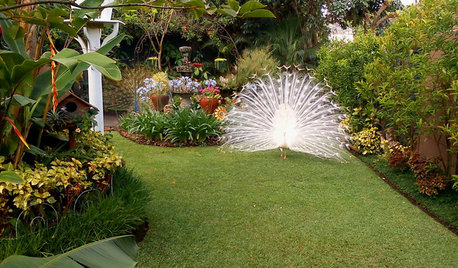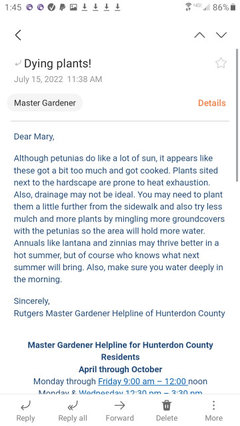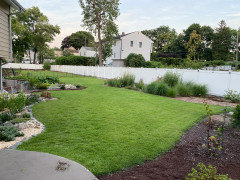Disease spreading all over my garden, I think its time to give up
Heruga (7a Northern NJ)
last year
last modified: last year
Featured Answer
Sort by:Oldest
Comments (43)
gardengal48 (PNW Z8/9)
last yearHeruga (7a Northern NJ)
last yearRelated Discussions
I think I have to give up on gardening
Comments (14)Wow sorry to hear about the bad news. I work in the utilities field, and have run across this problem before myself, ie gardens planted or extensive landscaping in our easements. It sounds like they are going to be replacing their gas lines. So the not so bad news is that unless there is some homeland security issue you'll be able to have your garden again after the work is done! Also as someone mentioned, if you politley and reasonably explain your situation to the crew doing the work, we will usually go out of our way to help you out...scraping your good garden soil up and off to the side out of our way, and then putting it back in place when we're done. Also while the situation does stink bear in mind that the crew doing the work is just a group of normal folks trying to make a living, and they had nothing to do with the situation. One other piece of advice, call the gas company and speak to them preferably whatever crew supervisor is doing the work(get a name first and last of the person you s/w) you may not have to move your whole garden...gas easements are huge...but if the main isn't deep they may only need you to move what you have thats within 5-10 feet of the pipe. My crew has worked many an hour of overtime, putting back someone's garden all because that person politely asked if we could help them out....See MoreJust when you think it's over and want to give up....
Comments (13)Hi Kathy!! I agree, you just never know... life does come from things least expected sometimes!!! I was really pleased to see these little stems. The funny thing about this is that i have this tree just sitting in my greatroom. The others are under lights and then some of my active trees are with this little sad looking tree. Im going to leave it right where it is. It must really like the conditions there. So...i will let it be! Dave, I was wondering the same thing!!! Tomorrow i will call Carol and ask her. I was always under the impression that they used seedlings as well. I will let you know!!! Happy New Year to you !!! Hi Kevin!!! If it is a Celadine, that will be wonderful!!! It really doesnt matter what it will be. It will still mean somethinng to me since it really wants to live! It looks so pathetic right now. I really didnt want to even take a pic of it, but it was so cute in its own way, i wanted to share!! LOL... I hope you all have a wonderful New Year!! Dont forget to eat your "Blackeyed Peas" today!!! I think i will even put a bean on this poor tree just for luck!!! : ) Take care, Laura...See MoreI think I'm giving up on Mme. Antoine Mari - Lisa?
Comments (22)Sheila, if you've put your pictures in files on your computer (for instance I have files for different years and different seasons) then it's not that to transfer pictures on houzz, it just takes a little getting used to. Even your "flat" MAM looks better than any of mine and the first pic is marvelous. I wouldn't be giving that rose away. So much is location, which includes any number of variables. Nik, I would be worried that your location is too hot, or will be in the future for this rose, but I don't think your place is usually as hot as mine. I'm glad some of you appreciate Mme. Leon Pain, and she is definitely growing on me. Right now she has 17 buds and that's not too bad. I actually think she's here to stay. Marlorena, you may be quite right, in spring she might be a wonder. Maybe I'll slip her some fish solution. Lisa, Happy Birthday! I just measured MAM and she's about 4 feet tall and 5 feet wide. I feel that it may be possible to pretty much keep her at this size and still have her bloom and thrive. Of all my roses this one is the most graceful and beautiful bush, with gorgeous leaves, but the flowers are so disappointing here. I'm glad the lump on your elbow is not something serious, although no doubt not much fun....See MoreMy last year in this apartment - giving up my gardens
Comments (30)Life isn't about the destination, it's about the journey. I love going on road trips. Although, I've never got up and just left everything behind, so to speak, I've often dreamed about it. People often get caught up in the mundane, working 9 to 5, busy, day-to-day routine that they lose sight of what truly matters. Before they know it, they look back on everything and wonder where all of the time went. Life isn't about existing, it's about living. It's about experiencing new things and having no regrets.I don't know you, but when I came across this post, I did want to wish you good luck on your journeys. That, and to tell you to take lots of pictures. Take pictures of everything, no matter how small or insignificant it may seem. When you look back on these photos, they'll take you back to those moments in your life and help to keep those memories alive. When I go through my photos, I can remember those precious moments as if they happened only yesterday. If you don't already have an Instagram account, this sounds like the perfect time to create one. For both you, and for those that wish you follow you....See Moregardengal48 (PNW Z8/9)
last yearlast modified: last yearfloral_uk z.8/9 SW UK
last yearHeruga (7a Northern NJ)
last yearHeruga (7a Northern NJ)
last yeargardengal48 (PNW Z8/9)
last yearlast modified: last yearHeruga (7a Northern NJ)
last yearlast modified: last yeargetgoing100_7b_nj
last yearHeruga (7a Northern NJ)
last yearlast modified: last yeargetgoing100_7b_nj
last yeargardengal48 (PNW Z8/9)
last yearHeruga (7a Northern NJ)
last yearlast modified: last yearlayerzsalon
last yearlayerzsalon
last yearHeruga (7a Northern NJ)
last yeartoxcrusadr
last yearlayerzsalon
last yearHeruga (7a Northern NJ)
last yearlayerzsalon
last yeargardengal48 (PNW Z8/9)
last yearlayerzsalon
last yearHeruga (7a Northern NJ)
last yearlast modified: last yeargardengal48 (PNW Z8/9)
last yearlayerzsalon
last yearlayerzsalon
last yearlayerzsalon
last yeartoxcrusadr
last yearJj J
last yearJj J
last yearlayerzsalon
last yearkevin9408
last yearlayerzsalon
last yearkevin9408
last yearlast modified: last yearHeruga (7a Northern NJ)
last yearJj J
last yearRose Star
last yearkevin9408
last yearHeruga (7a Northern NJ)
last yearlast modified: last yearkevin9408
last yearlast modified: last yearTed
last yearkevin9408
last year
Related Stories

GARDENING GUIDESNew Ways to Think About All That Mulch in the Garden
Before you go making a mountain out of a mulch hill, learn the facts about what your plants and soil really want
Full Story
LIFEYou Said It: ‘Give the Kitchen a Little Wake-Up Call’ and More
Design advice, inspiration and observations that struck a chord this week
Full Story
FALL AND THANKSGIVINGIt's Black and White and Fall All Over in a Holiday-Happy Home
Get inspired for budget-friendly fall decorating by a resourceful stylist's thrifty but sophisticated adornments
Full Story
LANDSCAPE DESIGNAll-White Gardens Light Up the Night
Lustrous blooms in white, cream and the palest ivory enchant in the landscape at night — and can be practical too
Full Story
GARDENING FOR BUTTERFLIESGardening for the Bees, and Why It’s a Good Thing
When you discover how hard bees work for our food supply, you may never garden without them in mind again
Full Story
GARDENING GUIDESGet a Head Start on Planning Your Garden Even if It’s Snowing
Reviewing what you grew last year now will pay off when it’s time to head outside
Full Story
LIGHTINGWhy It’s High Time to Reconsider Flush-Mount Lights
Look past your negative perceptions and see how versatile these lights can be
Full Story
INSPIRING GARDENSGarden Tour: It’s Always Spring in This Guatemalan Paradise
A landscape architect’s tropical garden dazzles with colorful flowers, rare peacocks, parrots and toucans
Full Story
LIFEIt’s National Novel Writing Month. How to Set Up Your Space
There’s nothing like a deadline to get creative sparks to fly. The right workspace (and coffee station) helps too
Full Story
DECORATING GUIDESFloral Decor: It’s All in the Mix
Find out how to use color, pattern and scale to make your room design come together
Full Story





toxcrusadr